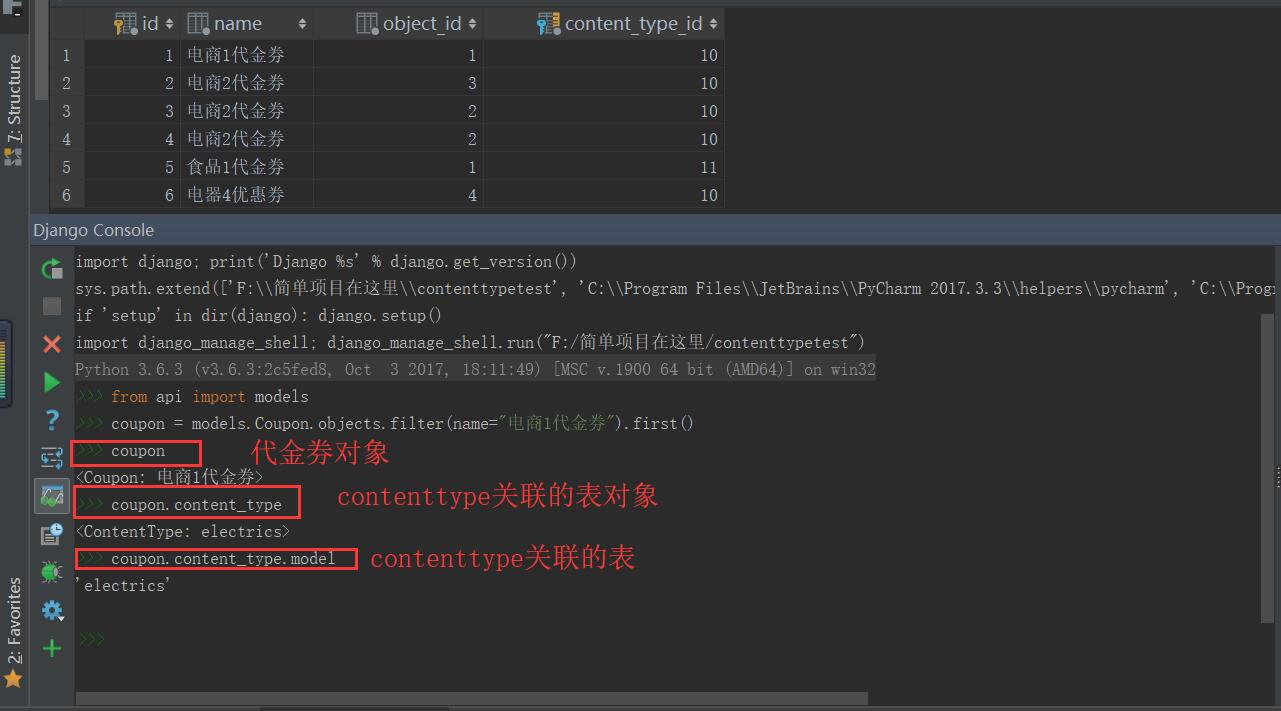Django学习之django自带的contentType表
通过django的contentType表来搞定一个表里面有多个外键的简单处理: 摘自:https://blog.csdn.net/aaronthon/article/details/81714496
contenttypes 是Django内置的一个应用,可以追踪项目中所有app和model的对应关系,并记录在ContentType表中。
models.py文件的表结构写好后,通过makemigrations和migrate两条命令迁移数据后,在数据库中会自动生成一个django_content_type表,比如我们有在models.py中写了这么几张表:
from django.db import models
class Electrics(models.Model):
"""
id name
1 日立冰箱
2 三星电视
3 小天鹅洗衣机
"""
name = models.CharField(max_length=32)
class Foods(models.Model):
"""
id name
1 面包
2 烤鸭
"""
name = models.CharField(max_length=32)
class Clothes(models.Model):
name = models.CharField(max_length=32)
class Coupon(models.Model): # 特殊关系表
"""
id name electric_id food_id cloth_id more... # 每增加一张表,关系表的结构就要多加一个字段。
1 通用优惠券 null null null
2 冰箱满减券 2 null null
3 面包狂欢节 null 1 null
"""
name = models.CharField(max_length=32)
electric = models.ForeignKey(to='Electrics', null=True)
food = models.ForeignKey(to='Foods', null=True)
cloth = models.ForeignKey(to='Clothes', null=True)
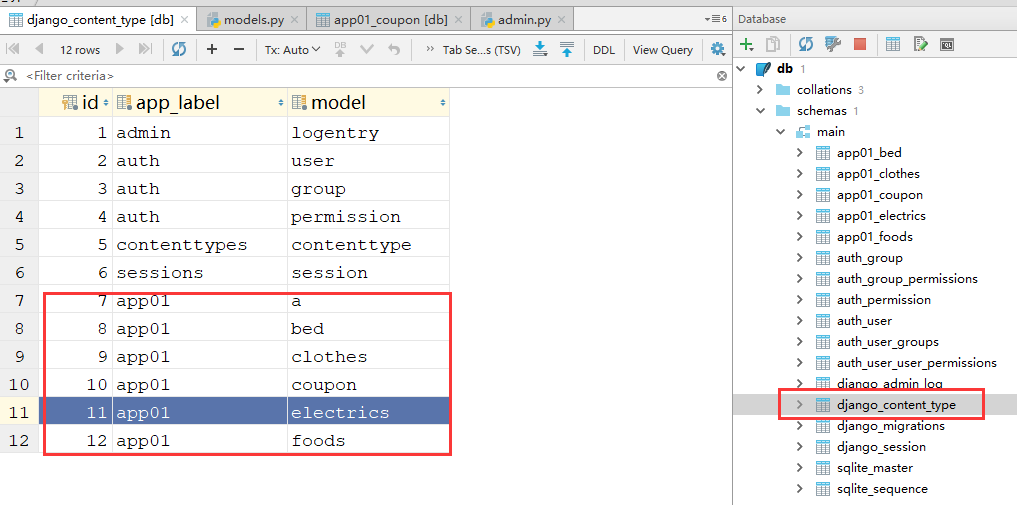
如果是通用优惠券,那么所有的ForeignKey为null,如果仅限某些商品,那么对应商品ForeignKey记录该商品的id,不相关的记录为null。但是这样做是有问题的:实际中商品品类繁多,而且很可能还会持续增加,那么优惠券表中的外键将越来越多,但是每条记录仅使用其中的一个或某几个外键字段。
contenttypes 应用
通过使用contenttypes 应用中提供的特殊字段GenericForeignKey,我们可以很好的解决这个问题。只需要以下三步:
在model中定义ForeignKey字段,并关联到ContentType表。通常这个字段命名为“content_type”
在model中定义PositiveIntegerField字段,用来存储关联表中的主键。通常这个字段命名为“object_id”
在model中定义GenericForeignKey字段,传入上述两个字段的名字。
为了更方便查询商品的优惠券,我们还可以在商品类中通过GenericRelation字段定义反向关系。
示例代码:models.py文件:
from django.db import models
from django.contrib.contenttypes.models import ContentType
from django.contrib.contenttypes.fields import GenericForeignKey, GenericRelation
class Electrics(models.Model):
name = models.CharField(max_length=32)
price = models.IntegerField(default=100)
coupons = GenericRelation(to='Coupon') # 用于反向查询,不会生成表字段
def __str__(self):
return self.name
class Foods(models.Model):
name = models.CharField(max_length=32)
price=models.IntegerField(default=100)
coupons = GenericRelation(to='Coupon')
def __str__(self):
return self.name
class Clothes(models.Model):
name = models.CharField(max_length=32)
price = models.IntegerField(default=100)
coupons = GenericRelation(to='Coupon')
def __str__(self):
return self.name
class bed(models.Model):
name = models.CharField(max_length=32)
price = models.IntegerField(default=100)
coupons = GenericRelation(to='Coupon')
class Coupon(models.Model):
"""
Coupon
id name content_type_id object_id_id
美的满减优惠券 9(电器表electrics) 3
猪蹄买一送一优惠券 10 2
南极被子买200减50优惠券 11 1
"""
name = models.CharField(max_length=32)
content_type = models.ForeignKey(to=ContentType,on_delete=models.CASCADE) # step 1 既然没有直接和关联表进行外键关系,我们通过这一步先找到关联表
object_id = models.PositiveIntegerField() # step 2 #存的是关联的那个表的对应的那条记录的id
content_object = GenericForeignKey('content_type', 'object_id') # step 3 对象.content_object直接就拿到了这个优惠券对象关联的那个商品记录对象。
def __str__(self):
return self.name
注意:ContentType只运用于1对多的关系!!!并且多的那张表中有多个ForeignKey字段。
数据化迁移,再给每张表添加数据
衣服表,电器表,床上用品表,美食表
添加完之后,数据迁移,python manage.py makemigrations 和 python manage.py migrate
创建记录和查询
from django.shortcuts import render, HttpResponse
from api import models
from django.contrib.contenttypes.models import ContentType
def test(request):
if request.method == 'GET':
# ContentType表对象有model_class() 方法,取到对应model
content = ContentType.objects.filter(app_label='api', model='electrics').first() # 表名小写
cloth_class = content.model_class() # cloth_class 就相当于models.Electrics
res = cloth_class.objects.all()
print(res)
# 为三星电视(id=2)创建一条优惠记录
s_tv = models.Electrics.objects.filter(id=2).first()
models.Coupon.objects.create(name='电视优惠券', content_object=s_tv)
# 查询优惠券(id=1)绑定了哪个商品
coupon_obj = models.Coupon.objects.filter(id=1).first()
prod = coupon_obj.content_object
print(prod)
# 查询三星电视(id=2)的所有优惠券
res = s_tv.coupons.all()
print(res)
总结: 当一张表和多个表FK关联,并且多个FK中只能选择其中一个或其中n个时,可以利用contenttypes app,只需定义三个字段就搞定!
创建记录
关系表的结构
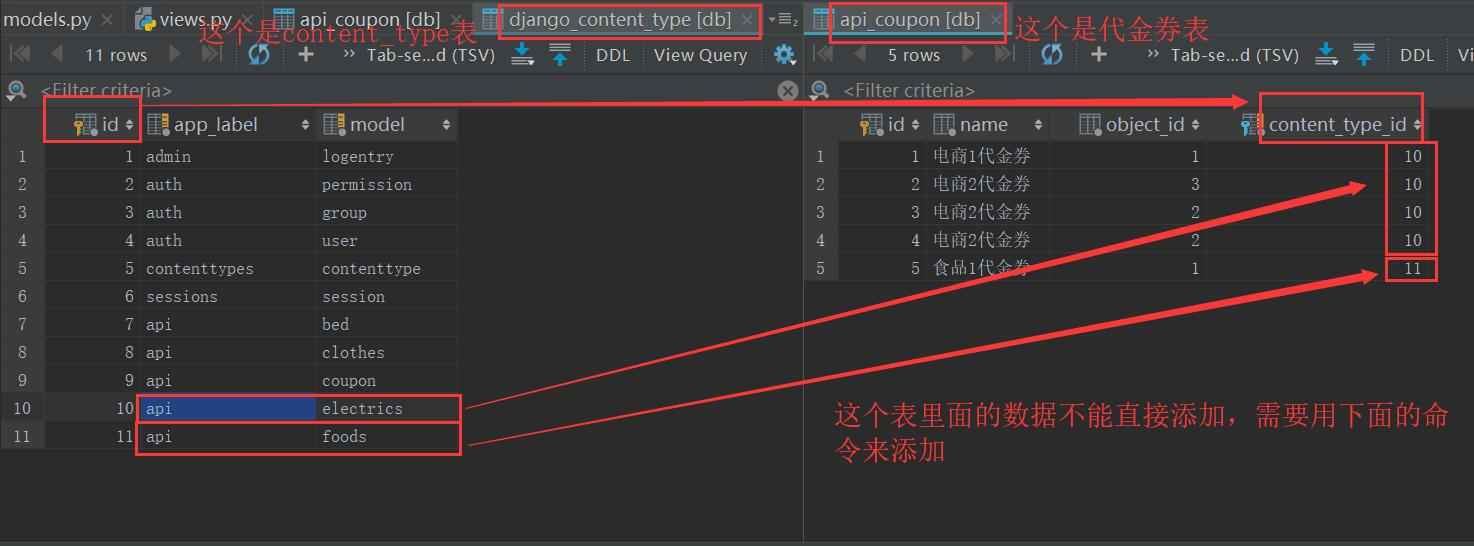
用语法给关系表加记录。
添加方式1:
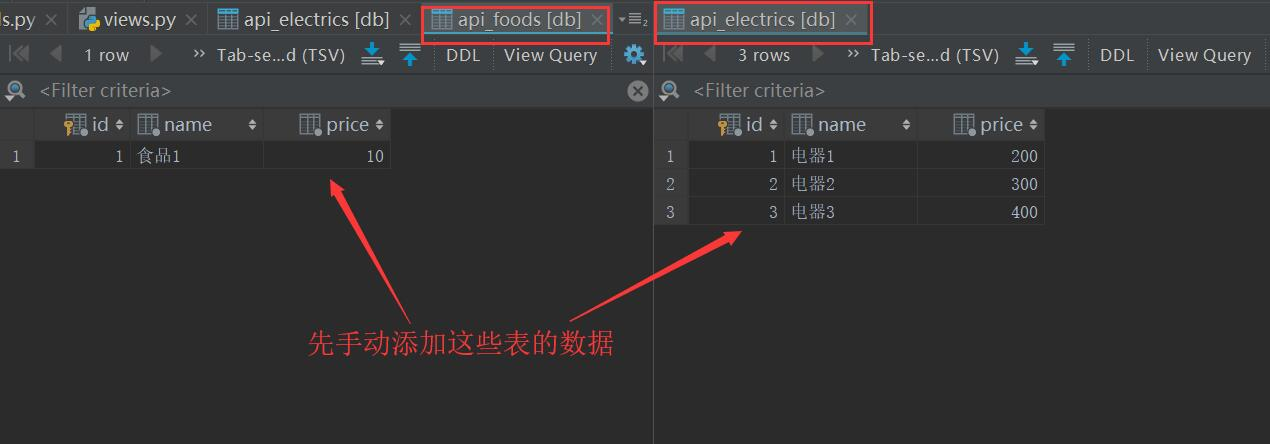
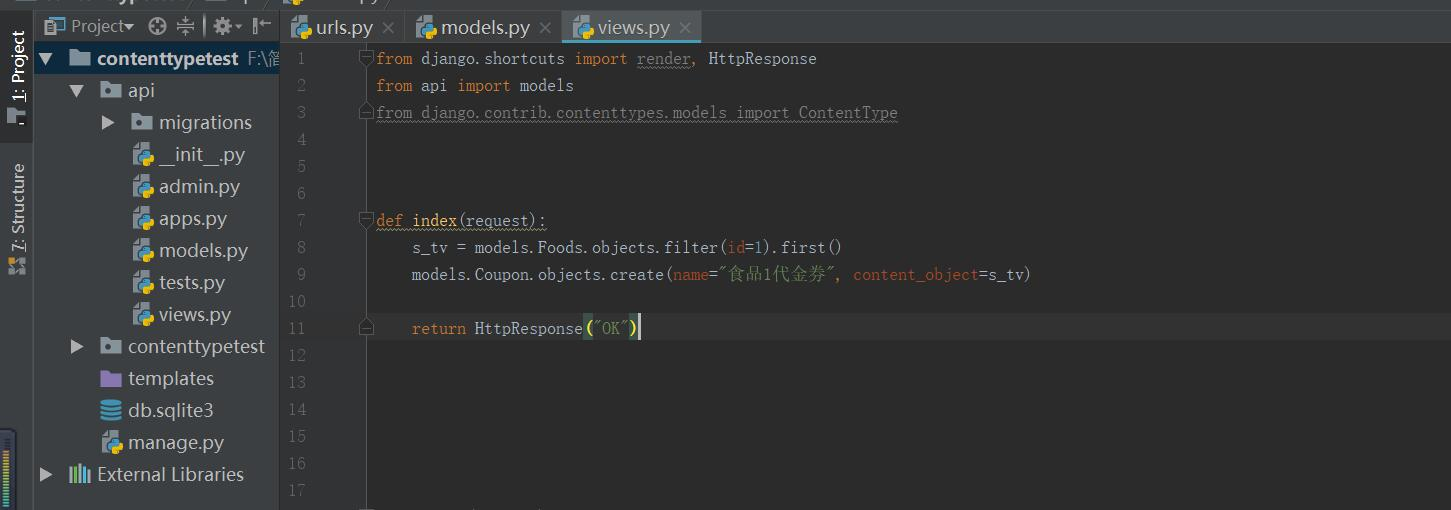
接下来用postmen来发送请求
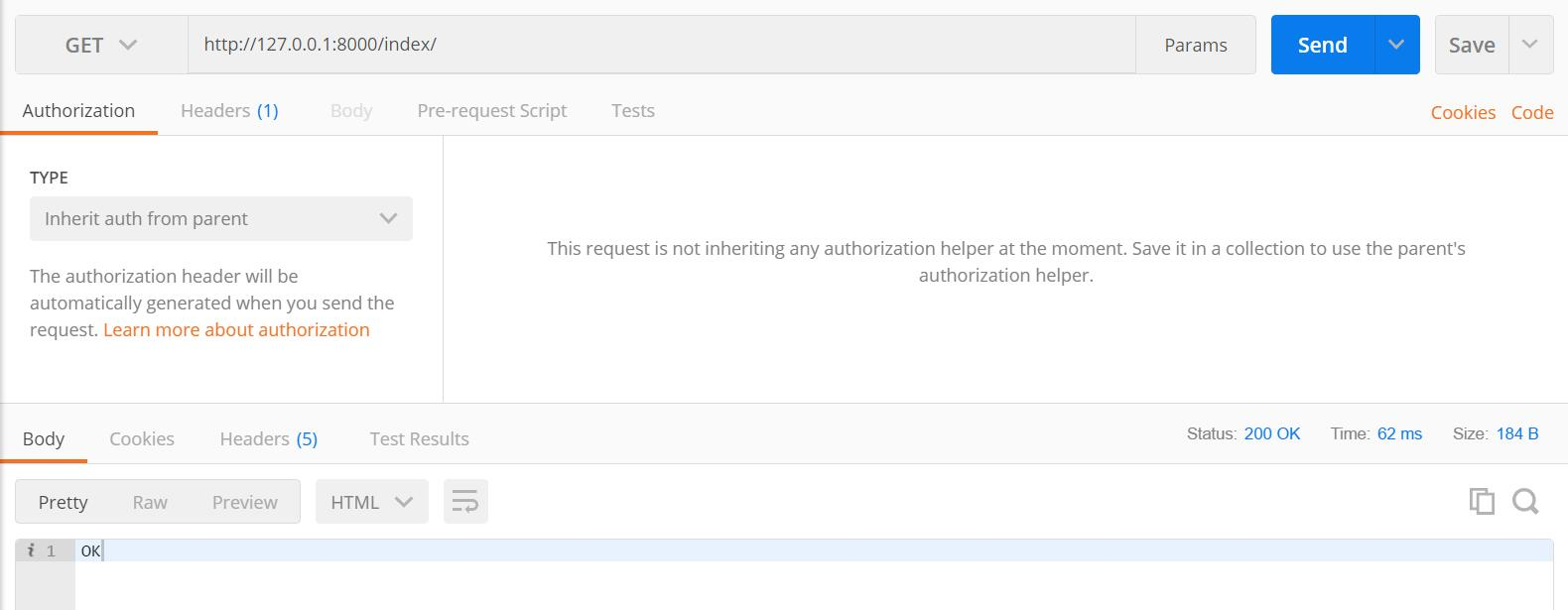
然后代金券表数据就添加完成了
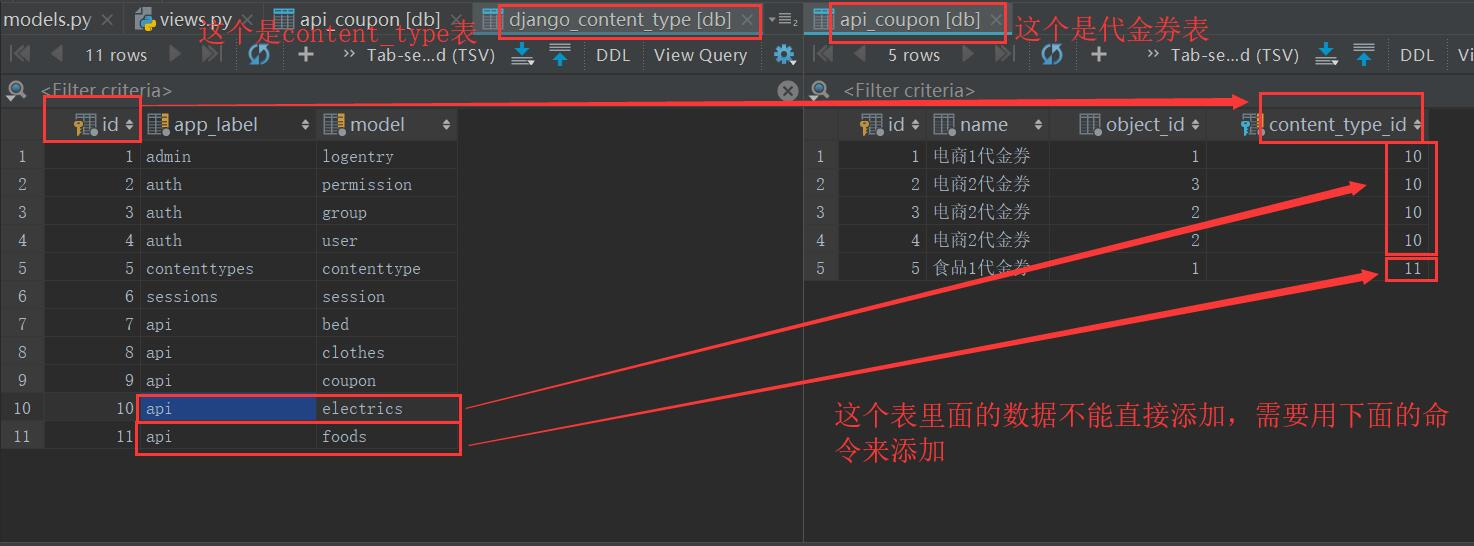
添加方式2:
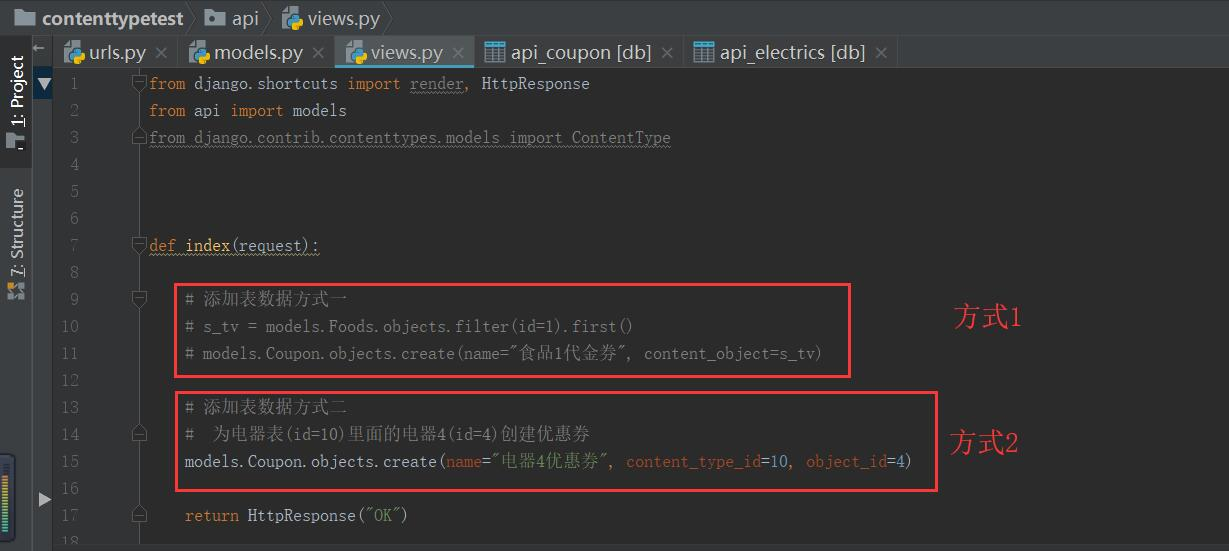
通过postmen发送请求结果
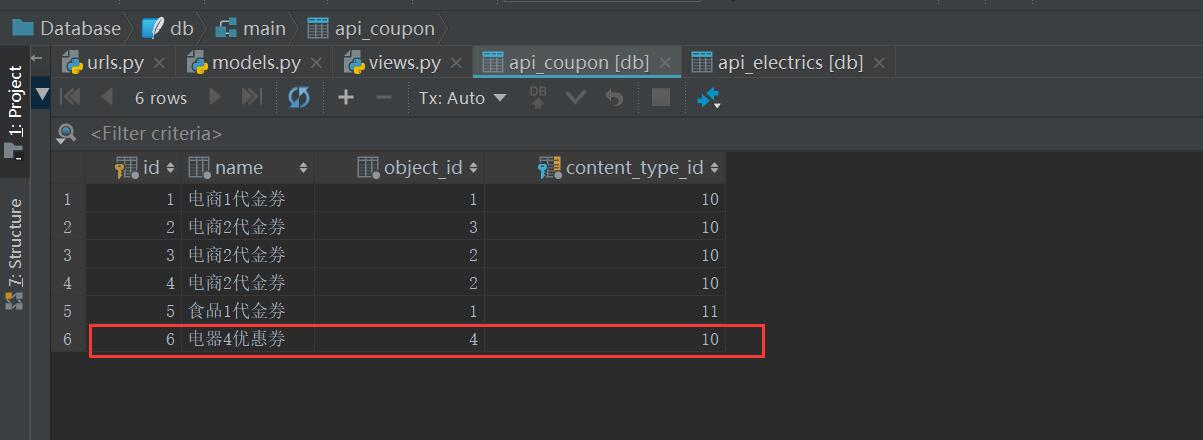
查询记录
查询name="电商1代金券"的代金券信息

